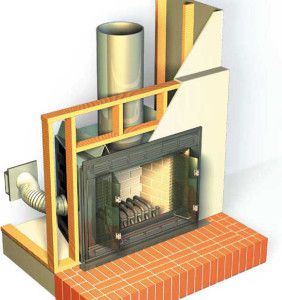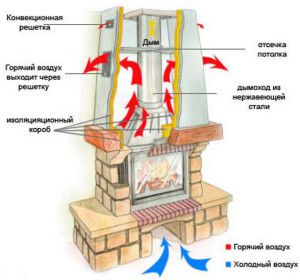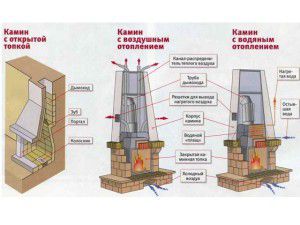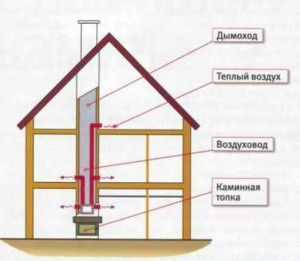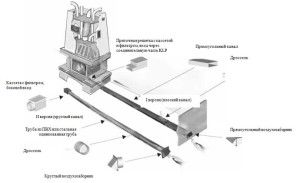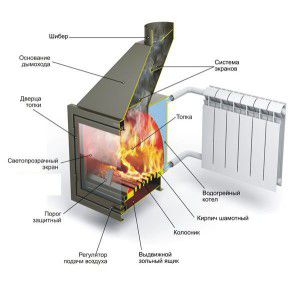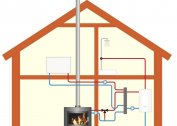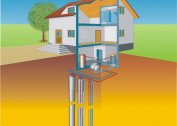How can aesthetics and functionality be combined in heating? Installation of traditional boilers is not always possible - there is no separate room, there is no gas main for the installation of compact models. In this case, an acceptable alternative would be heating a private house with a fireplace: gas, water, air. And before you begin to analyze its effectiveness - you need to familiarize yourself with the nuances.
Rules for organizing fireplace heating
Despite the seemingly small efficiency, air fireplace heating can completely replace traditional boiler systems. The main difference is the large combustion chamber, which can be open or closed (with a transparent screen).
This entails a large consumption of energy - solid fuel or gas. Also, in addition to a duct system or a heat exchanger for water heating, a room is heated by radiating heat from the fireplace body. Therefore, before you make a fireplace with water heating yourself, you need to consider the following:
- Large diameter chimney. This is due to the increased volume of the combustion chamber and, as a result, the need to provide maximum draft for air flow;
- Location. A fireplace insert for heating should be installed so that the front part is located along the diagonal of the room or its length. So thermal radiation will spread throughout the room;
- If there are ducts or water heating pipes, their wiring in the house is taken into account. The circulation of warm air (coolant) should be made so that the temperature in each room is approximately the same.
How to make home heating a fireplace? The most important point is to minimize heat loss and increase the efficiency of the entire system. To do this, it is necessary to correctly install the design and direct the heat received to heat the house.
The chimney for the fireplace does not have to be straight. By installing a system of air channels, you can increase the heat transfer to the room by heating the wall from hot gases.
Types of fireplaces and tips for arranging a fireplace
At the first stage, it is necessary to choose the correct model of the fireplace or choose the scheme of its construction. If there is a gas main, gas fireplaces for heating will be the best option. They are economical and have little inertia - the heating of air in the room occurs quickly.
Structurally, it consists of a combustion chamber, to which a duct from the street is connected. It is necessary for the influx of fresh air to maintain the combustion process. The optimal configuration includes a modular heating pad, in which there is the possibility of power regulation. Additionally, a fireplace with air or water heating includes a heat exchanger located directly in the combustion chamber.
But most often they use traditional solid fuel models. Their distinctive performance is as follows:
- A large amount of fuel to maintain the desired temperature level;
- The presence of an ash pan, which performs two functions - air supply to the furnace from the room and the collection of combustion products;
- Autonomy of work. For normal operation does not need a mandatory connection to electricity.
Heating a private house with a fireplace can be done in two ways - receiving heat from the walls of the structure and the presence of additional highways (air or water) for the circulation of the coolant. It all depends on the area of the house and the number of rooms, as well as the required capacity of the fireplace. In addition, an important factor is the frequency of operation of the heating system.
All these factors affect the cost of a fireplace insert for heating.
| Name / power, kW | Type of fireplace | Fuel | price, rub. |
| DBL-2000-DZ-1, 2 kW | Built in | Firewood | 17200 |
| Melody 920, 5 kW | Frontal | Firewood | 96860 |
| Santiago rincon, 8 kW | Angular | Gas | 203500 |
| Danville Brass FB2, 2 kW | Built in | Electricity | 74900 |
Installation of electrical models is advisable only for intermittent operation. But at the same time, their installation is much simpler than with gas or solid-fuel analogues.
It is best not to install a fireplace on the outside wall, so seasonal heat losses can be reduced.
Furnishing a fireplace in a private house
After choosing a suitable model, it is necessary to ensure its optimal functioning. All do-it-yourself fireplaces with air heating should transfer heat energy from combustion of fuel to the room as efficiently as possible.
Having installed a fireplace insert, you should take care of its lining. It performs several functions - protection against hard thermal radiation, heat storage and its partial reflection in the furnace to increase the heating rate of the heat exchanger. Traditionally, water-heated fireplaces are faced with the following materials:
- Plastering. Made for makeshift brick structures;
- Artificial or natural stone. It has good heat capacity, but installation is carried out only on a prepared surface. So, for factory steel or cast-iron furnaces it is necessary to make an intermediate construction of fireclay bricks;
- Tiles - porcelain, terracotta or majolica. Some models of solid fuel or gas fireplaces for heating have on the surface special mounting units for installing tiles.
During the design and installation of the fireplace should be guided by safety rules. The wall on which it will be mounted must be made of non-combustible materials. The same applies to the floor surface. Regardless of the chosen scheme, the heating system from the fireplace should be completely safe.
Drywall decoration can only be carried out for decorative fireplaces, whose surface does not heat up during operation. An alternative is the use of similar non-combustible materials.
Types of heating from the fireplace
If the fireplace will perform not only aesthetic functions, but also practical ones (organization of a heating system), you need to choose the optimal scheme for transferring thermal energy to the room. Depending on the operational characteristics of the house, you can make air heating with a fireplace or an analogue of water.
First you need to purchase a fireplace with an appropriate heat exchanger. If the design is done independently - it is made from improvised materials.
Air fireplace heating
The main difference between heating a private house by a fireplace is the transfer of thermal energy through air channels to other rooms of the building. To do this, you can purchase a ready-made model with an air heating chamber or make it yourself. The latter option is preferable, since it is possible to adjust its volume and the rated output power of the system.
In addition to installing a fireplace with air heating, the following system elements are required:
- Air heating chamber. It should be isolated from the furnace, as if to frame it. If a gas heating fireplace is installed, an air supply channel from the street must pass through the heating chamber for the burner to work;
- Distribution ducts. They are connected to the heating chamber and are necessary for supplying warm air to the premises of the house. To improve circulation, it is recommended to independently make fireplaces with air heating with a ventilation system;
- Channels for air to enter the heating chamber. It is best to install a unit for mixing air flows from the street and from the premises. So it is possible to simultaneously solve two problems - ventilation in the house and reducing the cost of heating the air mass.
One of the most important points in heating a house with a fireplace is the location of the heating chamber and the distribution duct. The easiest way to install the latter is on a draft ceiling with further concealment by a decorative surface. However, for such heating of a private house by a fireplace, there is one drawback - warm air will rise immediately upward, which will lead to an uneven thermal distribution. The lower part of the room will not warm up well.
It is best to use an alternative heating system from a fireplace with bottom mounting ducts.
Installation of channels takes place at the floor level. At the same time, they can be located both at the skirting part of the walls, and directly on the draft floor. When choosing a similar air heating with a fireplace, the owner of the house receives a number of advantages:
- Uniform distribution of warm air currents from the floor throughout the room;
- The ability to change power with adjustable dampers;
- Reducing costs during maintenance work with fireplace air heating with your own hands.
Design should include the selection of the optimal heating scheme using a fireplace - its power, the cross-section of the pipelines and their length. Additionally, the power of the forced air circulation system is calculated.
When choosing a scheme of air lines in heating a house with a fireplace, the pipelines should not deform or change their properties under the influence of high temperatures. Most often, galvanized or stainless pipes are chosen - corrugated or rigid.
Water fireplace heating
For ready-made designs, you can perform their small modernization and make a fireplace with water heating yourself. The essence of this procedure is to install the heat exchange unit in the furnace. An alternative is to purchase a finished fireplace with a water heat exchanger.
In this case, the fireplace replaces the traditional boiler - the thermal energy from the combustible fuel is transferred to the water. It also begins to circulate through the piping system and enters the radiators and pipes. However, the installation of fireplaces with water heating is associated with greater complexity, since it is necessary to provide for the installation of the following components:
- Circulation pump. It is necessary to normalize the velocity of the coolant;
- Expansion tank. It serves as protection against overheating - compensates for a critical increase in hot water temperature and pressure in pipes;
- Security group - air vent and water discharge valve.
In general, the principle of designing fireplace water heating with your own hands is no different from the standard. It is only necessary to take into account the relatively high energy consumption and inertia of the system.
Regardless of the choice of a fireplace with air or water heating, you should choose the right place for its installation. At the same time, aesthetic design features are taken into account - the ability to observe the combustion process. Therefore, most often facing fireplace inserts in the heating systems of a private house are installed in the living rooms.
The video shows an example of organizing safe water heating using a fireplace:

